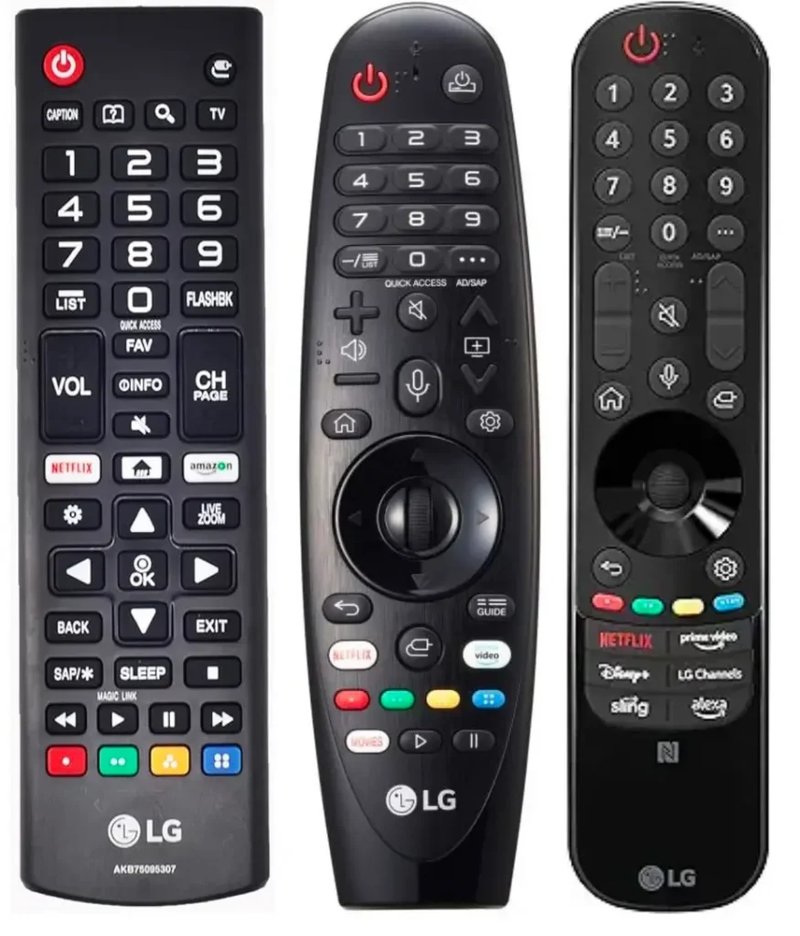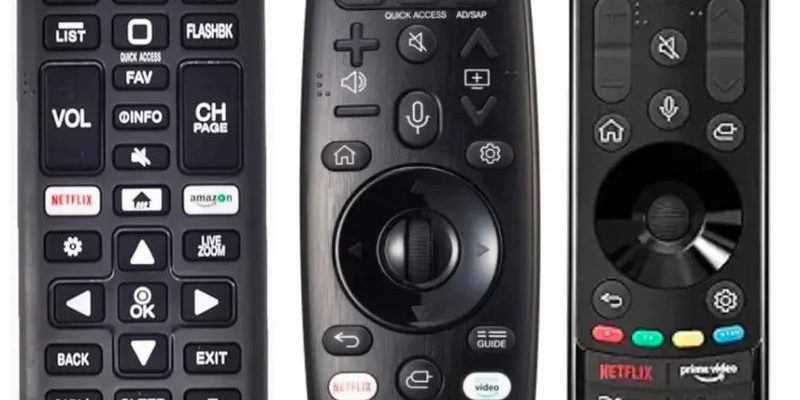
Honestly, when I first heard about this, I was skeptical. I figured, “Nah, remotes are picky—they only like their own TV!” But, turns out, with a bit of set up (and maybe some patience), you can use your LG TV remote to rule over your Blu-Ray player, set-top box, streaming stick, or even your soundbar. With a little syncing, some codes, and a couple of button presses, you can finally ditch that remote pile.
Understanding the LG TV Remote: More Than Just Volume and Channel
Let me explain why LG remotes aren’t your average clickers. Most newer LG TVs come with what’s called the “Magic Remote.” If you haven’t seen one, it sort of looks like something from a sci-fi movie—there’s a point-and-click function, scroll wheel, and a bunch of buttons that look suspiciously like they do more than just power and volume.
But here’s the thing: these remotes aren’t just fancy for show. They come packed with something called *universal remote* technology. Basically, inside that slim plastic shell is a tiny brain that can learn, mimic, and control other devices that speak infrared (IR) language or, for newer stuff, even over HDMI-CEC. So, if you feel like your remote should do more, you’re not wrong—it can. It just needs a nudge in the right direction.
You might be wondering if your remote is the right one for this. If your LG TV came with a remote that has a microphone button, scroll wheel, and a little “pointer” symbol, you’re in luck. That’s the Magic Remote, and it’s designed specifically for multi-device control. If yours is a more basic model, it can still do some of this magic, but features may be limited. Always double check your remote’s model in your TV manual or online.
How Device Control Works: IR, HDMI-CEC, and Pairing Explained
Let’s get into how all this works—because if you’re like me, “magic” is nice, but I want to know *how* the trick is done. LG remotes use a mix of old-school and new-tech methods to control devices. The classic way is with *infrared* (IR) signals. You point, you click, and the remote shoots an invisible beam, just like TV remotes have done since the 80s.
But there’s a newer, cooler method called *HDMI-CEC* (Consumer Electronics Control). It’s basically a secret handshake over the HDMI cable between your TV and whatever’s plugged in (like a soundbar or streaming box). When it’s enabled, your LG TV can send commands to these devices—think turning them on or off, changing sources, and sometimes even controlling playback.
Pairing (or syncing) your remote to another device usually involves entering a special code—sort of like telling the remote, “Hey, this is a Sony Blu-ray player,” or “That’s a Bose soundbar.” Your LG TV walks you through this process step by step, usually in the settings menu. If all goes well, you’ll be flipping between devices with one remote, and all those other remotes will start gathering dust.
Setting Up Device Control: Step-by-Step Guide for Beginners
All right, let’s walk through this like we’re doing it together—because the first time can be a bit, well, fiddly. Here’s how you get your LG remote to boss around your other gadgets:
- Open Universal Control Settings: On your LG TV, press the “Settings” button (it looks like a gear), then look for “Device Connection” or “Universal Control Settings.” This is where the magic begins.
- Select and Sync Your Device: The TV will show a list of device types—like soundbars, Blu-ray players, cable boxes, etc. Choose the one you want. The TV will then guide you to select the brand (Sony, Samsung, whatever).
- Enter Codes or Test Commands: Some devices need a code entered, which your TV will suggest. Other times, you’ll just test buttons—like hitting “Power” to see if it turns the device on or off. If something works, you confirm it. If not, you go to the next code.
- Finish & Check Control: When the test commands are working, finish the wizard. Try out the main functions—power, volume, input, playback—to make sure everything’s smooth.
*Remember*: If nothing responds, check that everything’s plugged in, turned on, and that your remote’s batteries aren’t on their last legs. I’ve been there, and yes, weak batteries can make you think you’re losing your mind!
Troubleshooting Common Problems With Multi-Device Control
Okay, sometimes stuff just refuses to work. You nail the sync, enter the code, and nothing happens. Or worse, it works… then suddenly stops. Here are some real-life pitfalls and ways to fix them:
- Signal Interference: Sometimes, other electronics or even bright sunlight can mess with infrared signals. Try moving any obstacles and check that you have a clear line of sight.
- Wrong Code or Brand: If your device isn’t responding, you might’ve picked the wrong brand or code. Don’t be afraid to run through the wizard again and try alternative options.
- Low Remote Battery: It’s silly, but weak batteries are the
- HDMI-CEC Not Enabled: For HDMI-connected devices, make sure HDMI-CEC is turned on both on your TV and the gadget. It might be called “SimpLink” on LG TVs. Without this, your remote won’t send or receive the right signals.
If your LG TV remote worked yesterday but isn’t working today, a quick reset (remove and reinsert batteries, or reboot your TV) often brings things back to life. Occasionally, a firmware update helps too—check your TV’s software settings for updates.
Codes, Pairing, and Sync: What Each Step Really Means
Those moments when the TV asks for a “code” can feel intimidating, right? But here’s the secret: codes are just like little keys. Each device brand (and sometimes model) has its own unlock code that tells your remote how to talk to it. LG TVs usually pull up the right list for you, so you don’t have to hunt around online.
Pairing is when your TV and remote do a quick handshake—think of it as two friends exchanging names so they recognize each other next time. Once paired, your remote will remember the device (so you only go through this pain once). Syncing is a catch-all term for making sure everything is, well, in sync—so when you push “Volume Up,” the right gadget responds.
One quirky thing: some older or off-brand devices might not have an exact code. In that case, try a generic code, or see if any of the “close enough” codes work for at least the basics like power and volume. It’s not perfect, but sometimes, half-control is better than none.
Comparing Magic Remote and Universal Remotes: Which Is Better?
You might be wondering: should I stick with the LG Magic Remote, or buy a fancy universal remote from the store? Here’s the lowdown. The LG Magic Remote is tailored for LG TVs and plays extra nice with LG’s smart features and their interface. It’s optimized for newer devices and can handle most modern gadgets you’d pair with a TV.
Universal remotes, on the other hand, are more like Swiss army knives. They’re meant to control just about anything, but sometimes lack the smooth integrations and “just works” features like pointer controls or voice search found on the Magic Remote. You may have to program more codes manually and not all shortcuts will match up.
If your home theater is simple—a TV, a soundbar, maybe a Blu-ray—the LG remote will likely do the trick. If you’re running a full AV system with every device imaginable, a dedicated universal remote (like Logitech Harmony) might make sense. But honestly, for most people, the built-in LG remote paired properly is the sweet spot between simplicity and power.
Resetting and Re-Pairing Your LG TV Remote (And Devices)
Sometimes, all your troubleshooting goes nowhere, and you hit that point—”Should I just start over?” Good news: resetting your LG remote and re-pairing everything isn’t too scary. On most LG TVs, you can go to settings, find the remote menu, and select a reset or “de-register” option. This wipes out the current pairings (don’t worry, your TV isn’t going to explode).
After that, follow the pairing steps again. Here’s a quick trick: holding down the “Back” and “Home” buttons at the same time, for a few seconds, often forces a re-pair mode on the Magic Remote. Your TV will confirm when it picks up the remote again, and you can redo your universal control setups from scratch. It feels a bit like clearing a cluttered desk—a fresh start can suddenly make everything work better.
Keeping It Running Smooth: Maintenance and Updates
Tech changes fast, right? One week, everything works, then—bam—your remote acts up. Here’s how to keep things smooth:
- Check for Firmware Updates: LG pushes out TV and remote firmware updates now and then. You’ll usually find this in the “About” section of your TV’s settings. Updating can fix bugs, improve compatibility, and even add new device codes.
- Keep Batteries Fresh: This one’s easy to overlook! Weak batteries cause laggy or unresponsive remotes, so swap them every 6-12 months (or sooner).
- Test Device Sync Regularly: If you add a new gadget, double-check that your remote still controls everything else as expected. Occasionally, you’ll need to re-sync devices after changes or updates.
Most problems can be solved by checking connections, toggling the TV’s “Device Connection” settings, or unplugging/replugging HDMI devices. Don’t let a small glitch turn into a weekend project!
Final Thoughts: Why Using One Remote Makes Life Easier
Having spent way too many nights crawling behind TVs, searching for lost remotes, I can absolutely vouch for the joy of controlling everything with just one remote—especially an LG TV Magic Remote. It’s a small life upgrade, like finally getting the right charger for your phone. The couch feels cozier, movie nights start faster, and yes, you look kind of techy in front of your friends.
So, keep your LG TV remote handy, give it a bit of setup time, and enjoy that smooth, single-remote experience. If you hit any snags, remember—troubleshooting, syncing, and even a full reset are all fair game, and usually get things working again. If nothing else, you’ll have one less reason to dig between the couch cushions. Happy channel surfing!
